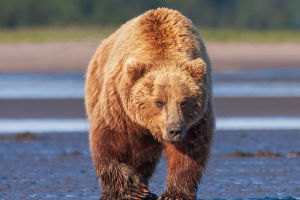Humpback whales are a species of baleen whale known for their massive size. Adult humpback whales can reach lengths of up to 16 meters and weigh up to 16 tons.
Despite their enormous size, humpback whales are gentle filter feeders. They take in large amounts of seawater, filtering out fish and krill through their baleen plates.
Gentleness might be the classic impression people have of humpback whales, but in recent years, they have gained fame for their encounters with killer whales. It's surprising to see the docile humpback whale engage in physical confrontations with the apex predator of the ocean. Their "heroic deeds" have become viral sensations on the internet.
Young humpback whales, being smaller in size, are preyed upon by killer whales. Killer whales attack solitary humpback whale mothers and calves, separating them and drowning them calves. Often, humpback whale mothers are helpless in these situations, doing their best to keep their calves from being pinned down by killer whales.
However, against the agile and coordinated attacks of killer whales, their resistance is futile. Killer whales are even known to kill blue whales, so what chance do a few humpback whales stand? Thus, many times, the calves become prey, and the mothers have no choice but to leave in solitude.
Sometimes, the dynamics of these encounters quickly become complicated. Observations have shown that adult male humpback whales gather in groups and rush to the battlefield. Unlike female humpback whales, males are larger and more muscular, equipped with powerful and intimidating "weapons" in the form of sharp barnacles on their fins.
Upon arrival, male humpback whales disrupt the situation, driving away killer whales, and preventing them from enjoying their spoils. Most of the time, killer whales have to leave with a sense of frustration. However, sometimes, killer whales return after the male humpback whales depart to resume their predation.
Humpback whales also come to the aid of pinnipeds such as seals and sea lions. In 1988, a humpback whale was observed rescuing a fur seal from a killer whale's mouth. Fifteen years later, in 2002, the same humpback whale was seen saving another fur seal. Occasionally, other whales become the targets of humpback whales during predation attempts.
Although false killer whales are relatively safe for humpback whale calves (but not entirely), as they prefer fish, there have been instances where humpback whales have chased them away from their prey.
Other animals may also benefit from the protection of humpback whales, with gray whales being a common beneficiary. In 2012, a mother gray whale and her calf were attacked by killer whales in Monterey Bay, USA.
Despite the efforts of the mother to lift her calf to the surface, they were unsuccessful. Seven humpback whales arrived and disrupted the killer whales in the water. Although the gray whale calf was ultimately killed, the humpback whales remained, interfering with the killer whales' feeding.
However, it's worth noting that humpback whales intervening in killer whale predation also put themselves in danger. Killer whales do occasionally prey on adult male humpback whales in the waters off Alaska. However, as cunning predators, killer whales prefer easier prey.
So, why do humpback whales exhibit such "chivalrous" behavior? On one hand, intervening in killer whale predation might be driven by the desire to protect relatives and engage in reciprocal behavior among humpback whales. If the attacked individual is a close relative, driving away the killer whale would benefit the continuity of their genes. On the other hand, it could simply be altruistic behavior.
Humpback whales can even distinguish between different ecotypes of killer whales based on their calls. They will follow the sounds to distant locations to confront and disrupt transient-type killer whales, thereby coexisting peacefully or even feeding together with fish-eating-type killer whales. Killer whales communicate during predation through vocalizations, and humpback whales respond to these sounds.
At that moment, humpback whales might not know who they are saving or even care. When they realize that the victim is not one of their "kin," some humpback whales may turn away, while others may engage in combat, even if it's just to save a sunfish.
In conclusion, the actions of humpback whales in intervening during orca predation events serve multiple purposes, including protecting kin, engaging in reciprocal altruism, and possibly pure altruism. Their behavior highlights the complex dynamics of marine ecosystems and the interconnectedness of marine species.


